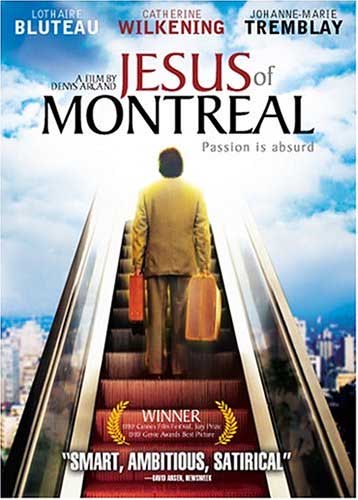The thesis: Theater asks questions, and the church provides a safe, nurturing context in which to wrestle with those questions. So how do we go about asking those questions in artistic ways that point people toward God?
Christians, especially Christians in the arts, cannot ignore the media's portrayal of Jesus. We have to trust that our faith is solid enough to stand being rattled around some. The first half of the semester, then, is about who our culture says Jesus is. This translates into our watching a lot of heretical movies.
---
Yiimimangaliso
 : The Mysteries
: The MysteriesIn the tradition of medieval mystery plays, Yiimimangaliso hits the high points of the redemption story from creation to Pentacost. The company is from South African.
The story of God's relationship with humanity is told mostly through percussion and dance, with smatterings of English, Afrikaans, Zulu and Xhosa. Angels wear chicken feathers. Adam and Eve are completely nude. Lucifer wears red pleather. Noah's flood mostly uses a watering can, and Jesus' entire childhood is depicted in a short, rhythmic game.
The only thing I can picture being offensive (unless you find dance in church offensive) is the occasional resemblance to minstrel shows. The company, though, is South African, not African American, so I don't know their familiarity with minstrelsy.
---
Leonard
 Bernstein's Mass
Bernstein's MassUnlike the other pieces we've talked about together, Bernstein's not-exactly-a-musical-and-not-quite-an-opera-and-certainly-not-a-straight-Mass is the only one that does not portray Jesus explicitly. The Celebrant and choir sing the traditional Latin text for the Mass, and they are interrupted periodically by parishioners voicing their doubts and demands. The chaos eventually takes its toll on the Celebrant (pastor). The congregation turns on him and demands he fix their lives. He eventually burns out, drops the chalice, and notices for the first time that red wine isn't red at all, but sort of brown and blue. He also rhymes "Adonai" with "I don't know," which gets him major points in my nerdy writing major book.
Some Wheaton friends accuse me of cynicism about the church, but I grew up in Greenville, Texas. Specifically, I grew up in Aldersgate (nondenominational) and then Highland Terrace (Southern Baptist), which gives me a juicy background of having some pastors being run off and other pastors running off on their own, all while their congregations squabble over nothing in particular. Bernstein's Mass portrays the church not as it should be but as it often is -- rich in history and truth but filled with people who are sometimes actively destructive, sometimes hypocritical, sometimes quietly struggling, and pastors aren't immune.
I have listened to the soundtrack on my own at least five times since we heard it in class.
---
Chocolate Jesus
 Cosimo Cavallaro exhibited his anatomically correct sculpture of Jesus during Holy Week 2007. It is entirely chocolate. We could neither confirm nor deny Cavallaro's interest in Tom Waits' Mule Variations.
Cosimo Cavallaro exhibited his anatomically correct sculpture of Jesus during Holy Week 2007. It is entirely chocolate. We could neither confirm nor deny Cavallaro's interest in Tom Waits' Mule Variations.I am less offended by this now that Walgreens has their Easter candy out. There are chocolate crosses right there next to the bunnies and eggs. They are four dollars. I am much more offended by those than by the Cavallaro sculpture. We are supposed to eat the body of Christ, though it is usually somewhat healthier -- a torn piece of bread or an oyster cracker.
There is nothing cute about this Cavallaro's Jesus. He is naked and in pain. The crosses at Walgreens were adorable enough to make you forget they were instruments of torture. Nobody eats chocolate electric chairs or even chocolate guns.
---
Jesus of Montreal
 It's 1988, and a Canadian bishop asks a young director to revamp the parish's decades-old passion play. The director gathers actors -- some with more experience in beer commercials than any other venue -- and revamps not only the presentation of the Passion story but also the entire script, incorporating recent archeological digs in the Palestine and soliloquys from Hamlet. The Catholic church is not pleased.
It's 1988, and a Canadian bishop asks a young director to revamp the parish's decades-old passion play. The director gathers actors -- some with more experience in beer commercials than any other venue -- and revamps not only the presentation of the Passion story but also the entire script, incorporating recent archeological digs in the Palestine and soliloquys from Hamlet. The Catholic church is not pleased.As the film goes on, the actors get their own identities entangled with their characters, and the movie becomes allegorical. The actors are disciples. The director is Jesus. A slick lawyer is Satan. A film studio is the temple. Art is religion.
That last bit is where I have the hiccough: It seems like art turns into a replacement religion somewhere along the way. That, as well as a few stray comments about everyone finding their own seperate paths to salvation, is probably why the movie was considered so offensive. Unless I missed something, which is possible, since the movie was in French and subtitles don't always cut it.
Oh, and crucifixion is crucifixion, and ____ ______ is resurrection. I won't ruin it for you; see the movie.
---
But I am about to ruin another movie, because neither its craft nor its theology earn it a recommendation.
The Last Temptation of Christ
 I once heard a speaker at a youth camp say that, ever since this movie came out, he's boycotted everything by anyone involved in the abomination, and he encouraged us to do the same. (I know David Bowie's pocketbook is seriously hurting from losing his teenage Southern Baptist demographic after his role as Pontius Pilate.)
I once heard a speaker at a youth camp say that, ever since this movie came out, he's boycotted everything by anyone involved in the abomination, and he encouraged us to do the same. (I know David Bowie's pocketbook is seriously hurting from losing his teenage Southern Baptist demographic after his role as Pontius Pilate.)Willem Dafoe is a kind of anti-Christ, not in a Tim LaHaye/Jerry B. Jenkins sense, but in that his attitude is opposite of Christ's in almost every scene. Scorsese's Christ is not sinless, he's just too cowardly to commit any particularly noteworthy sins. He wants to be a regular guy, but God won't leave him alone. Neither will Satan, for that matter. As a result, he comes down off the cross, gets married a few times, has kids, chews out Paul for misrepresenting him. Judas acts like the only one with much sense at all; despite Judas' best efforts, Jesus has ruined humanity's chance at salvation. Maybe there are other interpretations, but that's what came across after one (admittedly sleepy) viewing.
Any Christians left in the theater probably walked out by the Jesus/Mary Magdelene sex scene (which our professor graciously censored), but they missed the big surprise twist at the end of the movie:
It was a dream. The whole time. Like Dorothy and Donnie, Jesus has a vision of an outrageous scenario in which he escapes the regular world and has a chance to do what he's always wanted to do. Then he wakes up, back on the cross, and the credits roll in all their 80's majesty. Peter Gabriel sings.
It's like bad Bible fanfiction. As far as craft goes, Last Temptation is to film as Left Behind is to literature. It just happens to swing crazy-liberal instead of crazy-conservative. I don't know which one is more upsetting. Last Temptation is more blasphemous, but Left Behind is more misleading. At least Scorsese disclaimed at the beginning that his film is not based at all on the Gospels, while LaHaye and Jenkins are marketed like their novels are realistic portrayals of Revelation.
---
The media saturates us with its own images of Jesus and the church. They are loudest when they use a microphone and megaphone at the same time. What are they finding out about him when they come to church?
Ain't it crazy
What's revealed when you're not looking all that close
Ain't it crazy
How we put to death the ones we need the most?

